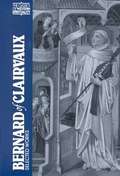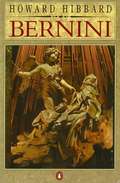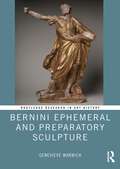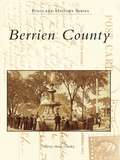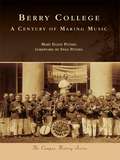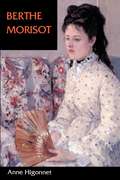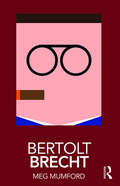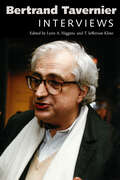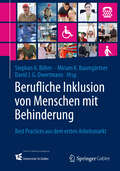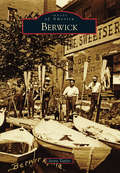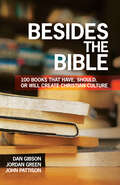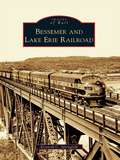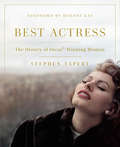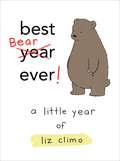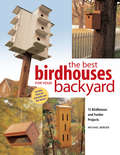- Table View
- List View
Bernard of Clairvaux: Selected Works
by Bernard Of Clairvaux Jean Leclercq Ewert Cousins G. R. EvansHere are writings of the great medieval spiritual teacher (1090-1153) who was preacher of the Crusades and founder of the Cistercians, with an introduction on the forming of Bernard's spirituality, its character and influence.
Bernardino Poccetti and the Art of Religious Painting at the End of the Florentine Renaissance (Visual and Material Culture, 1300-1700)
by Douglas DowBy almost any measure Bernardino Barbatelli, called Poccetti, was a successful and sought after painter in late sixteenth-century Florence, but his works have remained largely overlooked. This study situates representative examples of his religious painting within their respective contexts to demonstrate how Poccetti and his patrons negotiated the increasingly fraught terrain of sacred painting in the period of religious reform. These case studies demonstrate how patrons ranging from the Dominicans to the Carthusians to prominent Florentine patricians relied on Poccetti’s skill in creating compelling narratives that reflected current concerns within the Catholic world. In the process, Poccetti invoked an august Florentine tradition of fresco painting, shaping it to better address the demands placed on religious imagery at the end of the Renaissance.
Bernini
by Franco MormandoSculptor, architect, painter, playwright, and scenographer, Gian Lorenzo Bernini (1598-1680) was the last of the great universal artistic geniuses of early modern Italy, placed by both contemporaries and posterity in the same exalted company as Leonardo, Raphael, and Michelangelo. And his artistic vision remains palpably present today, through the countless statues, fountains, and buildings that transformed Rome into the Baroque theater that continues to enthrall tourists today. It is perhaps not surprising that this artist who defined the Baroque should have a personal life that itself was, well, baroque. As Franco Mormando's dazzling biography reveals, Bernini was a man driven by many passions, possessed of an explosive temper and a hearty sex drive, and he lived a life as dramatic as any of his creations. Drawing on archival sources, letters, diaries, and--with a suitable skepticism--a hagiographic account written by Bernini's son (who portrays his father as a paragon of virtue and piety), Mormando leads us through Bernini's many feuds and love affairs, scandals and sins. He sets Bernini's raucous life against a vivid backdrop of Baroque Rome, bustling and wealthy, and peopled by churchmen and bureaucrats, popes and politicians, schemes and secrets. The result is a seductively readable biography, stuffed with stories and teeming with life--as wild and unforgettable as Bernini's art. No one who has been bewitched by the Baroque should miss it.
Bernini
by Howard HibbardSculptor and architect Bernini was the virtual creator and greatest exponent of Baroque in 17th century Italy. He has left his greatest mark on Rome where Papal patronage provided him with enormous architectural commissions.
Bernini
by Howard HibbardSculptor and architect Bernini was the virtual creator and greatest exponent of Baroque in 17th century Italy. He has left his greatest mark on Rome where Papal patronage provided him with enormous architectural commissions.
Bernini Ephemeral and Preparatory Sculpture (Routledge Research in Art History)
by Genevieve WarwickTaking up questions of artists’ materials and technical processes currently at the vanguard of art-historical scholarship, this book studies the contiguity and interchange of workshop methods in the linked fabrication of both ephemeral and preparatory works by Bernini. Genevieve Warwick argues that the ephemeral arts of ritual occasion acted as a locus of artistic experiment for the artist in many respects similar to his use of preparatory models, to suggest that Bernini’s artistry sprang from the fabric of ritual in both material and cultural terms. From processional floats to court stage sets for the ritual occasions of church and state, such ephemeral arts were largely made of wax, clay, papier mâché, wood, stucco and plaster, assembled into scenographic ensembles with textiles, canvas and paint. Similarly, Bernini’s preparatory models for marble or bronze sculpture were of plaster and clay, even mud and straw, or wax and painted wood, as plentiful and affordable materials that were readily available for use and reuse as required. This book will be of interest to scholars working in art history and Renaissance studies.
Bernini: His Life and His Rome
by Franco MormandoSculptor, architect, painter, playwright, and scenographer, Gian Lorenzo Bernini (1598–1680) was the last of the great universal artistic geniuses of early modern Italy, placed by both contemporaries and posterity in the same exalted company as Leonardo, Raphael, and Michelangelo. And his artistic vision remains palpably present today, through the countless statues, fountains, and buildings that transformed Rome into the Baroque theater that continues to enthrall tourists today.It is perhaps not surprising that this artist who defined the Baroque should have a personal life that itself was, well, baroque. As Franco Mormando’s dazzling biography reveals, Bernini was a man driven by many passions, possessed of an explosive temper and a hearty sex drive, and he lived a life as dramatic as any of his creations. Drawing on archival sources, letters, diaries, and—with a suitable skepticism—a hagiographic account written by Bernini’s son (who portrays his father as a paragon of virtue and piety), Mormando leads us through Bernini’s many feuds and love affairs, scandals and sins. He sets Bernini’s raucous life against a vivid backdrop of Baroque Rome, bustling and wealthy, and peopled by churchmen and bureaucrats, popes and politicians, schemes and secrets.The result is a seductively readable biography, stuffed with stories and teeming with life—as wild and unforgettable as Bernini’s art. No one who has been bewitched by the Baroque should miss it.
Berrien County
by Sherry Arent CawleyAs one of the earliest developed areas of the state of Michigan, Berrien County has a rich history that appeals to the locals as well as the tourists who still enjoy the many treasures to be found there. Author Sherry Arent Cawley has compiled over 200 vintage postcards chronicling the life and times of this historic area.The historic Benton Harbor Fruit Market, Silver Beach, the mineral baths at the Whitecomb Hotel, and the House of David are all featured here in vivid postcards, some never before published, with accompanying captions. Images of Grand Beach, Niles, New Buffalo, Paw Paw Lake, and Berrien Springs offer readers a nostalgic glimpse into a Berrien County of yesteryear.
Berry College: A Century of Making Music
by Mary Ellen PethelThe history of Berry College is rooted in its musical culture and reflects an important part of Martha Berry's life and mission for her school. Located 60 miles north of Atlanta, Berry College began in 1902 as a small rural school, driven by Martha's desire to educate impoverished children and young adults in the foothills of the Appalachian Mountains. Through tireless fund-raising and dedication, Berry School grew from its humble beginning into an exemplary four-year liberal arts college. As Martha Berry gained widespread notoriety for her work in education, the music program performed for such guests as Henry Ford, Emily Vanderbilt, Theodore Roosevelt, and other notable leaders in business and politics. By 1948, the school's unofficial motto was "Everybody Sings at Berry." With continued success over the last 60 years, Berry's musical groups continue to gain recognition as they perform locally, nationally, and internationally.
Berthe Morisot
by Anne HigonnetOf the six Impressionist painters whose first exhibition scandalized and fascinated Paris in 1874, Berthe Morisot was the only woman. She reached a pinnacle of artistic achievement despite the restraints society placed on her sex, adroitly combining her artistic ambitions with a rewarding family life. Anne Higonnet brings fully to life an accomplished artist and her world.
Berthold Lubetkin’s Highpoint II and the Jewish Contribution to Modern English Architecture
by Deborah LewittesIn 1935, the Russian-born Jewish architect Berthold Lubetkin and his firm Tecton designed Highpoint, a block of flats in London, which Le Corbusier called ‘revolutionary’. Three years later, Lubetkin completed a companion design. Yet Highpoint II felt very different, and the sense that the ideals of modernism had been abandoned seemed hard to dispute. Had modern architecture failed to take root in England? This book challenges the belief that English architecture was on hiatus during the 1930s. Using Highpoint II as a springboard, Deborah Lewittes takes us on a journey through the defining moments of modern English architecture – the ‘high points’ of the period surrounding Highpoint II. Drawing on Lubetkin’s work and his writings, the book argues that he advanced influential, lasting theories which were rooted in his design for Highpoint II. Lubetkin’s work is explored within the context of wider Jewish emigration to London during the interwar years as well as the anti-Semitism that pervaded Britain during the 1930s. As Lewittes demonstrates, this decade was anything but quiet. Providing a new perspective on twentieth-century English architecture, this book is of interest to students and scholars in architectural history, urban studies, Jewish studies, and related fields.
Bertolt Brecht (Routledge Performance Practitioners)
by Meg MumfordBertolt Brecht’s methods of collective experimentation, and his unique framing of the theatrical event as a forum for change, placed him among the most important contributors to the theory and practice of theatre. His work continues to have a significant impact on performance practitioners, critics and teachers alike. Now revised and reissued, this book combines: an overview of the key periods in Brecht’s life and work a clear explanation of his key theories, including the renowned ideas of Gestus and Verfremdung an account of his groundbreaking 1954 production of The Caucasian Chalk Circle an in-depth analysis of his practical exercises and rehearsal methods. As a first step towards critical understanding, and as an initial exploration before going on to further, primary research, Routledge Performance Practitioners are an invaluable resource for students and scholars.
Bertolt Brecht: Journals 1934 - 1955 (Diaries, Letters And Essays Ser.)
by Bertolt BrechtThis book contains selected poems, plays, and prose by Bertolt Brecht taken from various points throughout his career. It includes translations of two prose works and provides some background information on Brecht's life and career.
Bertrand Tavernier: Interviews (Conversations with Filmmakers Series)
by Lynn A. Higgins and T. Jefferson KlineBertrand Tavernier (1941–2021) was widely considered to be the leading light in a generation of French filmmakers who launched their careers in the 1970s in the wake of the New Wave. In just over forty years, he directed twenty-two feature films in an eclectic range of genres from intimate family portrait to historical drama and neo-Western. Beginning with his debut feature—L’Horloger de Saint-Paul (1974), which won the prestigious Louis Delluc Prize—Tavernier showed himself to be a public intellectual. Like his films, he was deeply engaged with the pressing issues facing France and the world: the consequences of war, colonialism and its continuing aftermath, the price of heroism, and the power of art. A voracious cinephile, he was immensely knowledgeable about world cinema and American film in particular. Tavernier’s roots were in Lyon, the birthplace of the cinema. He founded and presided over the Institut Lumière, which hosts retrospectives and an annual film festival in the factory where the Lumière brothers made the first films. In this collection, containing numerous interviews translated from French and available in English for the first time, he discusses the arc of his career following in the lineage of the Lumière brothers, in that his goal, like theirs, is to “show the world to the world.” It is no surprise, then, that an interview with Tavernier is a treat. Beginning with discussions of his own films, the interviews in this volume cover a vast range of topics. At the core are his thoughts about the ways cinema can inspire the imagination and contribute to the broadest possible public conversation.
Berufliche Inklusion von Menschen mit Behinderung: Best Practices aus dem ersten Arbeitsmarkt
by Miriam K. Baumgärtner David J.G. Dwertmann Stephan A. BöhmDie berufliche Inklusion von Menschen mit Behinderung ist ein zentrales, jedoch noch zu wenig beachtetes Thema des Personalmanagements. Das vorliegende Buch stellt Best-Practice-Beispiele aus dem ersten Arbeitsmarkt vor. Es entstand am Center for Disability and Integration der Universität St. Gallen (CDI-HSG). Inspiriert durch den "Com(mitment) To Act(ion)"-Wettbewerb werden verschiedenste Unternehmensbeispiele zentralen Handlungsfeldern des Personalmanagements zugeordnet. Hierdurch sollen Führungskräften und Personalverantwortlichen geeignete Konzepte an die Hand gegeben werden, um die Inklusion von Menschen mit Behinderung aktiv voran zu treiben.
Berwick (Images of America)
by Jessie TaylorFirst settled in 1631, Berwick is the ninth-oldest town in Maine. Its unique location on the border of Maine and New Hampshire has served as one of the most popular gateways between the two states for centuries. Berwick was home to Gen. John Sullivan, a military officer in the Revolutionary War, and James Sullivan, the seventh governor of Massachusetts. Berwick was also the site of the country's first sawmill, powered by the Salmon Falls River. In the 1800s, sawmills gave way to cotton mills, all which continued to depend on the river for their livelihood. In 1935, Berwick became the headquarters of Prime Tanning, which grew to be the country's most dominant leather tannery. Today, Berwick is shifting its focus back to the river, not as a means to support factory life, but rather as a place to gather and engage in community activities. Berwick traces the history of a town that has overcome economic hardship and looks to continued revitalization in the future.
Berwyn
by Douglas DeuchlerEight miles west of downtown Chicago sits a suburb with a rich, vibrant history. Berwyn began in the 19th century as two separate communities with vast stretches of marshland and farmland between. By the early 1900s, this booming municipality successfully kept industry at bay while remaining a strictly residential development. As thousands of bungalows were constructed in the 1920s, the "City of Homes," as it was known, became the fastest-growing community in the United States. For many generations, the suburb has attracted hard-working people who take pride in their homes and exemplify the fulfillment of the American Dream.
Berwyn Heights (Then and Now)
by Ann Harris DavidsonBerwyn Heights is a village juxtaposed with an American metropolis, as it lies barely 10 miles from the heart of Washington, D.C. It has changed much since its beginnings in 1888, yet it retains its small-town advantages, illustrating that, though a place may change, its essence remains.
Besides the Bible: 100 Books that Have, Should, or Will Create Christian Culture
by John Pattison Dan Gibson Jordan GreenBesides the Bible
Besides the Screen
by Virginia Crisp Gabriel Menotti GonringNew media technologies impact cinema well beyond the screen. This volume speculates about the changes in modes of accessing, distributing, storing and promoting moving images and how they might affect cinematographic experience, economy and historiography.
Besler's Book of Flowers and Plants: 73 Full-Color Plates from Hortus Eystettensis, 1613 (Dover Pictorial Archive)
by Basilius BeslerWhen Prince Bishop von Gemmingen founded Germany's famous garden at Eichstätt in the early seventeenth century, its lush beauty was recorded in magnificent copperplate engravings. Later published as the Hortus Eystettensis by Basilius Besler, the colorful plates expertly mirrored the diversity of the celebrated garden, making it a great treasure of botanical literature.This collection gathers the finest illustrations from that historic study. Meticulously reproduced and carefully identified, here are the rare plants, flowers, and trees that once flourished throughout the grounds of Eichstätt's palace gardens. A thriving source of design ideas and horticultural information, this glorious gallery of art will endlessly delight artists, designers, and botanical enthusiasts.
Bessemer and Lake Erie Railroad
by Kenneth C. SpringirthAndrew Carnegie's vision of transporting iron ore from his boats on Lake Erie to his Pittsburgh steel mills was realized when he obtained ownership of a series of railroad companies in the region. In 1900, these companies became the Bessemer and Lake Erie Railroad, which connected the Lake Erie ports of Erie, Pennsylvania, and Conneaut, Ohio, south to North Bessemer near Pittsburgh. Through vintage photographs, Bessemer and Lake Erie Railroad highlights the railroad passenger excursions to Conneaut Lake Park and the steam and diesel locomotives used on the well-maintained line. The railroad continues to serve the steel industry today and in May 2004 was acquired by the Canadian National Railway.
Best Actress: The History of Oscar®-Winning Women
by Stephen TapertIngrid Bergman. Audrey Hepburn. Elizabeth Taylor. Jane Fonda. Meryl Streep. The list of women who have won the coveted and legendary Academy Award for Best Actress is long and varied. Through this illustrious roster we can trace the history of women in Hollywood, from the rise of Mary Pickford in the early 20th century to the #MeToo and Time’s Up movements of today, which have galvanized women across the world to speak out for equal pay, respect, power, and opportunity. This lavishly illustrated coffee table book offers a vital examination of the first 75 women to have won the Best Actress Oscar over the span of 90 years. From inaugural recipient Janet Gaynor to Frances McDormand’s 2018 acceptance speech that assertively brought women to the forefront, Best Actress: The History of Oscar®-Winning Women serves to promote a new appreciation for the cinematic roles these women won for, as well as the real-life roles many of them played – and still play – in advancing women’s rights and equality. Stories range from Bette Davis’ groundbreaking battle against the studio system; to the cutting-edge wardrobes of Katharine Hepburn, Diane Keaton and Cher; to the historical significance of Halle Berry’s victory; to the awareness raised around sexual violence by the performances of Jodie Foster, Brie Larson, and others. Showcasing a dazzling collection of 200 photographs, many of which have never before been seen or published, Best Actress honors the legacies of these revered and extraordinary women while scrutinizing the roadblocks that they continue to overcome.
Best Bear Ever!: A Little Year of Liz Climo
by Liz ClimoCome spend some time in Liz Climo's world! The artist and popular blogger returns with another collection of her comics--this time following the seasons with her most beloved characters. Fans love Liz Climo's charmingly funny animal kingdom, which was first featured in The Little World of Liz Climo and Lobster is the Best Medicine.Best Bear Ever! follows Bear and Rabbit, along with their other friends (including Otter, Sloth, Skunk, and Turtle), to commemorate special days throughout the year, while also embarking on fun adventures to celebrate the seasons. When you have good pals like these, any time of year can be the BEST EVER!
Best Birdhouses for Your Backyard
by Michael BergerBuild birdhouses that attract the birds you want!Most birdhouse books are overly complex, with intricate projects that take hours of work. Are they attractive? Sure. But useful? Depends.The Best Birdhouses for Your Backyard puts birds' needs first! You'll find more than a dozen easy-to-build projects that include: • Information about the bird each house attracts, including vital statistics • Guidelines for strategic placement of your birdhouses • Considerations for making sure your birds are safe and comfortable • Special tips for dealing with raccoons and other predators • Complete materials list • Advice on hardware and supplies • Detailed step-by-step instructions • Special woodworking tipsYou'll also find guidelines for choosing woods that can outlast the elements, charts with tool descriptions and comparisons, resource lists, construction techniques, finishing advice and more. You'll have fun in the shop while providing safe, attractive homes for your favorite feathered friends.
